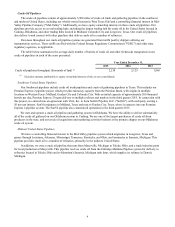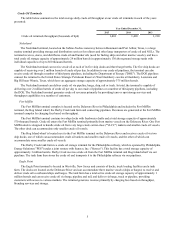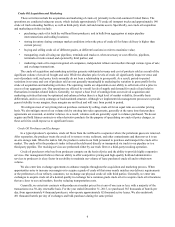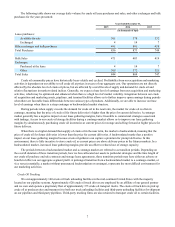Sunoco 2015 Annual Report Download - page 16
Download and view the complete annual report
Please find page 16 of the 2015 Sunoco annual report below. You can navigate through the pages in the report by either clicking on the pages listed below, or by using the keyword search tool below to find specific information within the annual report.14
Competition
Pipeline Operations
Our pipelines face competition from a number of sources, including major oil companies and other common carrier
pipelines. Generally, pipelines are the lowest-cost method for long-haul commodity movements. Therefore, the most significant
competitors for large volume shipments are other pipelines. Competition among pipelines is based primarily on access to
commodity supply, market demand, and transportation charges offered for commodity movements. In addition, in areas where
additional infrastructure is needed to accommodate production needs, we compete with other pipeline providers to offer the
necessary transportation services to meet market demand. Our management believes that high capital requirements,
environmental considerations, and the difficulty in acquiring rights-of-way and related permits make it difficult for other
companies to build competing pipelines in certain areas served by our pipelines. As a result, competing pipelines are likely to
be built only in those cases in which strong market demand and attractive tariff rates support additional capacity in an area.
In addition to competition from other pipelines, we face competition from trucks and rail that deliver products in a
number of areas that we serve. While their costs may not be competitive for longer hauls or large volume shipments, these
sources of transportation compete effectively for incremental and marginal volume in many areas where such means of
transportation are prevalent.
Terminalling Services
Terminal facilities compete based on pricing, accessibility to supply and distribution locations and flexibility of the
terminal facility’s service offering. Our terminal facilities service the crude oil, NGLs and refined products markets in the
southwest, midwest and northeast United States.
Throughput at our Nederland terminal includes both crude oil and NGLs. The primary competitors of the Nederland
terminal are its refinery customers' docks and other terminal facilities located in the Beaumont, Texas area with similar
capabilities to distribute these commodities to the end-user markets.
Our Marcus Hook Industrial Complex has the capability to handle the processing, storage and distribution of crude oil,
NGLs and refined products and has access to local, domestic and waterborne markets. An increase in competition for the
facility could result from the development of a facility providing similar service offerings.
Our refined products marketing terminals located in the northeast, midwest and southwest United States compete with
other independent terminals on price, versatility, and services provided. The competition primarily comes from integrated
petroleum companies, refining and marketing companies, independent terminal companies, and distribution companies with
marketing and trading activities.
The majority of the throughput at our crude oil terminal facilities in the northeast relates to refining operations at PES's
Philadelphia refinery. In 2012, we entered into a 10-year agreement to provide terminalling services to PES at the Fort Mifflin
terminal complex. For further information, see Item 7. "Management's Discussion and Analysis of Financial Condition and
Results of Operations-Agreements with Related Parties."
Acquisition and Marketing Activities
Our competitors for our acquisition and marketing of crude oil, NGLs and refined products include other petroleum
products pipeline companies, major integrated oil companies and their marketing affiliates, independent gatherers, banks that
have established trading platforms, and brokers and marketers of varying sizes, financial resources and experience. Some of
these competitors have capital resources many times greater than ours, and control or have access to greater supplies of the
specific commodities that we market. Competitive factors that impact our acquisition and marketing activities include price and
contract flexibility, regional pricing differentials, availability of commodity supply and demand, quantity and quality of services
offered, and accessibility to end markets. Our acquisition and marketing of NGLs includes butane blending services. Our
patents provide us with the exclusive use and control over the technology utilized to provide these services to our customers.
























